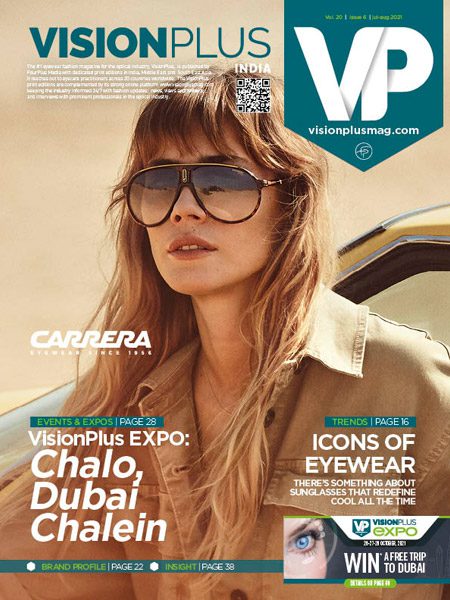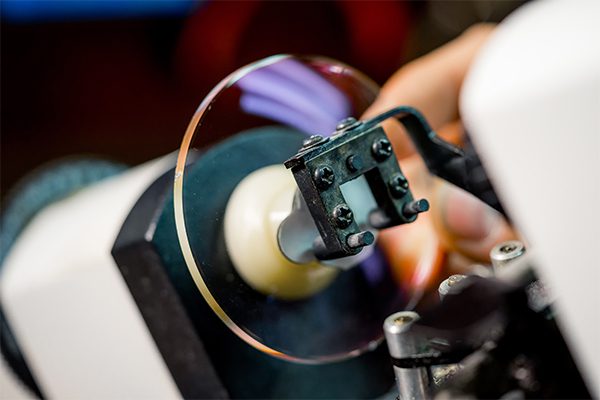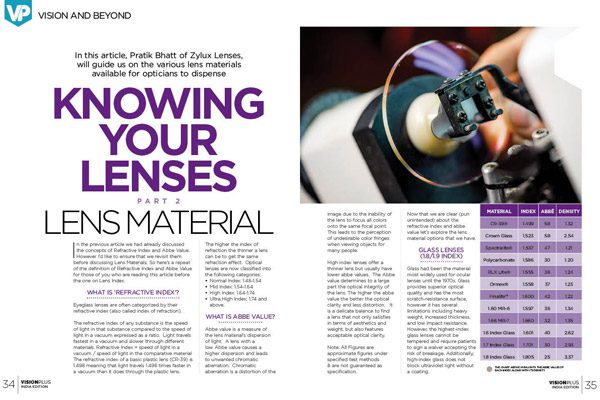

Knowing Your Lenses part 2 Lens Material
In this article, Pratik Bhatt of Zylux Lenses, will guide us on the various lens materials available for opticians to dispense
In the previous article we had already discussed the concepts of Refractive Index and Abbe Value. However I’d like to ensure that we revisit them before discussing Lens Materials. So here’s a repeat of the definition of Refractive Index and Abbe Value for those of you who are reading this article before the one on Lens Index.
What Is ‘Refractive Index’?
Eyeglass lenses are often categorized by their refractive index (also called index of refraction).
The refractive index of any substance is the speed of light in that substance compared to the speed of light in a vacuum expressed as a ratio. Light travels fastest in a vacuum and slower through different materials. Refractive Index = speed of light in a vacuum / speed of light in the comparative material The refractive index of a basic plastic lens (CR-39) is 1.498 meaning that light travels 1.498 times faster in a vacuum than it does through the plastic lens.
The higher the index of refraction the thinner a lens can be to get the same refraction effect. Optical lenses are now classified into the following categories:
- Normal Index: 1.48-1.54
- Mid Index: 1.54-1.64
- High Index: 1.64-1.74
- Ultra High Index: 1.74 and above.

What Is Abbe Value?
Abbe value is a measure of the lens material’s dispersion of light. A lens with a low Abbe value causes a higher dispersion and leads to unwanted chromatic aberration. Chromatic aberration is a distortion of the image due to the inability of the lens to focus all colors onto the same focal point. This leads to the perception of undesirable color fringes when viewing objects for many people.
High index lenses offer a thinner lens but usually have lower abbe values. The Abbe value determines to a large part the optical integrity of the lens. The higher the abbe value the better the optical clarity and less distortion. It is a delicate balance to find a lens that not only satisfies in terms of aesthetics and weight, but also features acceptable optical clarity.
Note: All Figures are approximate figures under specified test methods & are not guaranteed as specification.
Now that we are clear (pun unintended) about the refractive index and abbe value let’s explore the lens material options that we have.
Glass Lenses (1.8/1.9 Index)
Glass had been the material most widely used for ocular lenses until the 1970s. Glass provides superior optical quality and has the most scratch-resistance surface, however it has several limitations including heavy weight, increased thickness, and low impact resistance. However, the highest-index glass lenses cannot be tempered and require patients to sign a waiver accepting the risk of breakage. Additionally, high-index glass does not block ultraviolet light without a coating.
Standard Plastic CR-39 Lenses (Columbian Resin)
These are conventional plastic material lenses with a refractive index of 1.498 that have been widely used since their introduction in 1947. One of the biggest advantages of this lens is its affordability. It also provides good optical clarity and is easy to tint. Some disadvantages of this material are that it scratches easily, does not provide adequate UV protection, is not as impact resistant as other lenses and is also heavier and thicker than the higher index plastics.
It should be noted however, that a scratch resistance coat, as well as a UV coating can be applied to the lens helping to reduce some of these deficiencies. CR-39 plastic lens material is usually only recommended for those with a weak prescription where lens thickness and weight are not a concern and for dress eyewear in which safety is not an issue.
CR-39 lenses have a high Abbe value of 59.3 making them the lenses with the least distortion from dispersion/chromatic aberration.
Polycarbonate Lenses
Polycarbonate lenses offer up to 10 times more impact resistance than regular CR39 lenses. Hence, this type of lens, along with Trivex, are the lenses of choice for safety glasses, children’s eyewear, and for anyone who wants durable yet thin lenses.
They are also lab favourites for use in rimless frames, because polycarbonate lenses can be easily drilled and resist cracking around the drill holes.
A disadvantage of polycarbonate is that it is naturally a soft material causing it to scratch much easier. However, unlike CR-39 basic plastic lenses, a scratch resistant coating is almost always standard as it is applied when the lenses are made. With higher refractive indexes, there are often more chromatic aberrations, meaning visual disturbances of light, that can be interpreted as blur by some. Chromatic aberrations are higher in polycarbonate lenses. The abbe value of polycarbonate is 30, the lowest of all lens materials making it the worst lens for optical clarity and integrity. Plenty of people cannot adapt to a polycarbonate lens.
Trivex Lenses
Trivex is a relatively new optical lens material. It has the ultraviolet blocking properties (380 nanometers and less) and shatter resistant properties of polycarbonate. However, Trivex lenses have a much higher abbe value (43-45) vs. polycarbonate (abbe value 30) making it much better in optical clarity with fewer chromatic aberrations. Trivex also has a slightly lower density so it is lighter than polycarbonate. In fact, Trivex is the lightest weight lens material available. Another advantage that Trivex has over polycarbonate is that it can be easily tinted. Trivex is great for rimless frames and those frames that require drill mount screws through the lenses.





